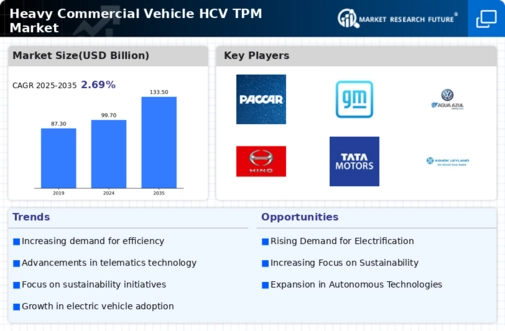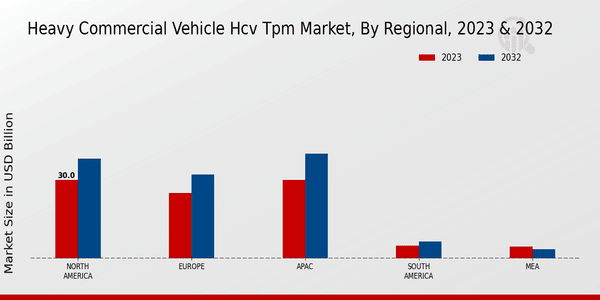Market Growth Projections
The Global Heavy Commercial Vehicle HCV TPM Market Industry is poised for steady growth, with projections indicating a compound annual growth rate (CAGR) of 2.69% from 2025 to 2035. This growth trajectory reflects the increasing demand for heavy commercial vehicles across various sectors, including construction, logistics, and agriculture. The market is expected to expand from 99.7 USD Billion in 2024 to 133.5 USD Billion by 2035, highlighting the potential for investment and innovation within the industry. As stakeholders respond to evolving market dynamics, the HCV TPM sector is likely to witness significant developments that align with global economic trends.
Infrastructure Development Initiatives
Infrastructure development initiatives are significantly impacting the Global Heavy Commercial Vehicle HCV TPM Market Industry. Governments are investing in transportation infrastructure, including roads, bridges, and logistics hubs, to facilitate efficient freight movement. This investment not only enhances the operational efficiency of heavy commercial vehicles but also stimulates demand for new vehicles. As infrastructure improves, the logistics sector is likely to expand, creating opportunities for HCV manufacturers. The ongoing focus on infrastructure development is expected to contribute to the market's growth, with projections indicating a market size of 133.5 USD Billion by 2035, driven by increased freight activity.
Rising Urbanization and Population Growth
Rising urbanization and population growth are key drivers of the Global Heavy Commercial Vehicle HCV TPM Market Industry. As urban areas expand, the demand for goods transportation increases, necessitating a robust fleet of heavy commercial vehicles. The growing population is expected to lead to higher consumption levels, further fueling the need for efficient logistics solutions. This trend is likely to create a favorable environment for HCV manufacturers, as they adapt to the evolving needs of urban logistics. The interplay between urbanization and market demand suggests a sustained growth trajectory for the heavy commercial vehicle sector in the coming years.
Regulatory Support for Emission Reductions
The Global Heavy Commercial Vehicle HCV TPM Market Industry is influenced by stringent regulations aimed at reducing emissions and promoting environmental sustainability. Governments worldwide are implementing policies that encourage the adoption of cleaner technologies in heavy vehicles. This regulatory support is likely to drive manufacturers to innovate and produce vehicles that comply with these standards. As a result, the market is expected to witness a shift towards greener alternatives, enhancing the appeal of heavy commercial vehicles. The emphasis on sustainability is anticipated to shape consumer preferences, further propelling the market's growth in the coming years.
Increasing Demand for Freight Transportation
The Global Heavy Commercial Vehicle HCV TPM Market Industry is experiencing a surge in demand for freight transportation, driven by the expansion of e-commerce and global trade. As companies seek efficient logistics solutions, the need for heavy commercial vehicles has intensified. In 2024, the market is projected to reach 99.7 USD Billion, reflecting a robust growth trajectory. This demand is likely to be sustained as industries increasingly rely on heavy vehicles to meet their supply chain requirements. The growth in freight volumes is expected to contribute significantly to the market's expansion, indicating a positive outlook for the HCV TPM sector.
Technological Advancements in Vehicle Efficiency
Technological innovations are playing a pivotal role in shaping the Global Heavy Commercial Vehicle HCV TPM Market Industry. The introduction of advanced telematics, fuel-efficient engines, and alternative fuel technologies is enhancing vehicle performance and reducing operational costs. These advancements not only improve fuel efficiency but also align with global sustainability goals. As a result, fleet operators are increasingly investing in modern heavy vehicles equipped with cutting-edge technologies. This trend is expected to drive market growth, as companies aim to optimize their logistics operations while minimizing environmental impact, thereby reinforcing the industry's relevance in a rapidly evolving market landscape.




















